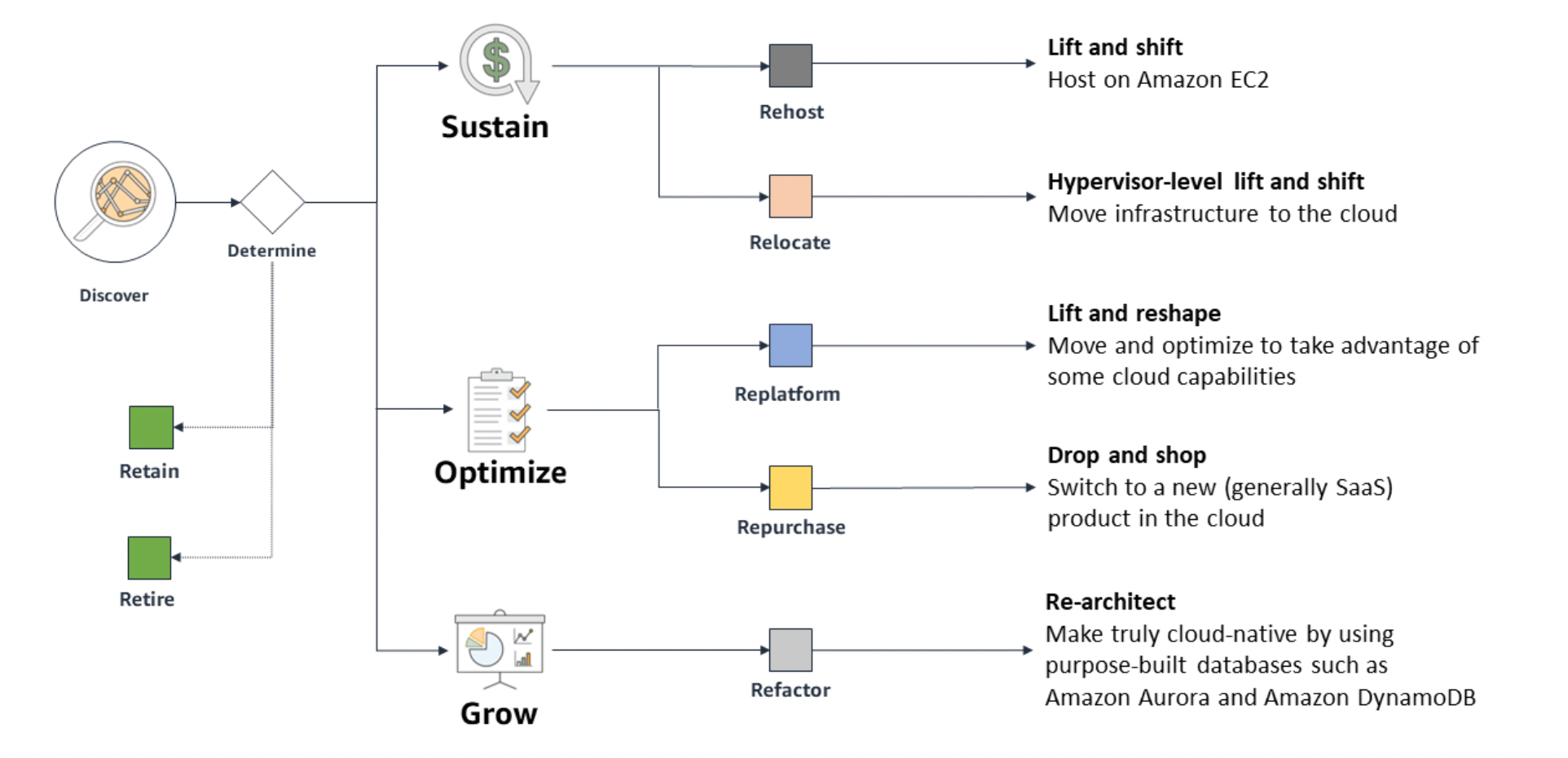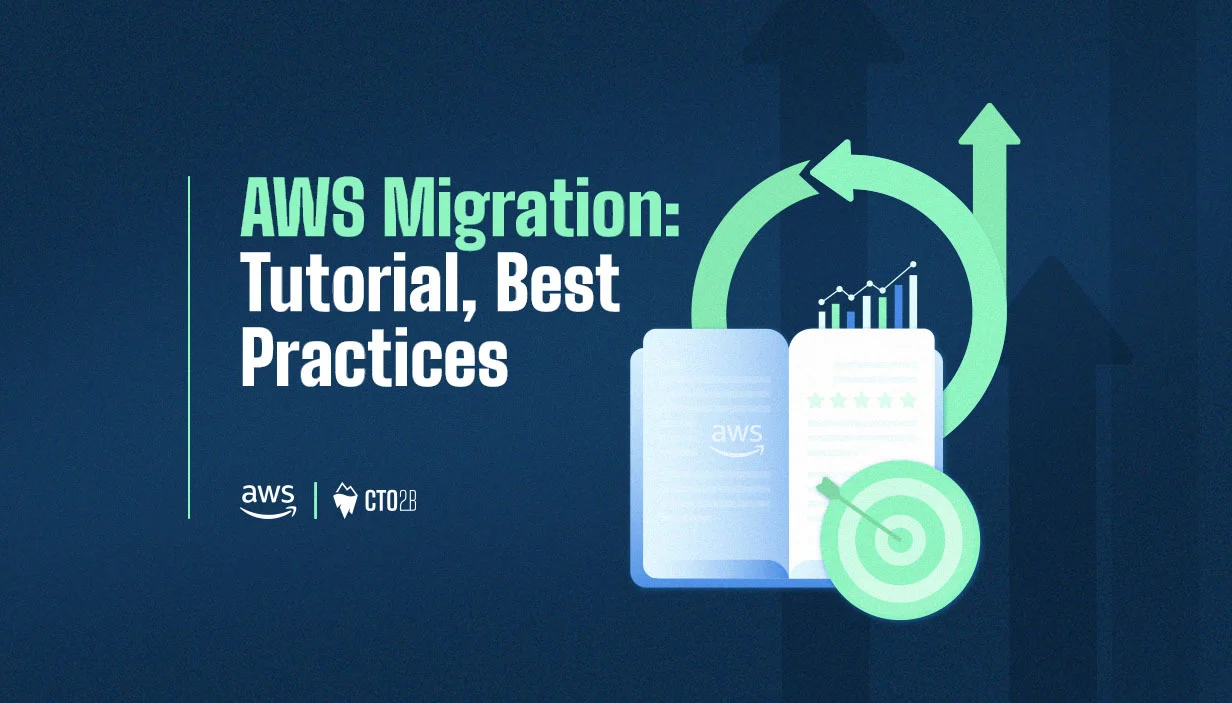Seamless AWS Migration Starts Here
Migrating to Amazon Web Services (AWS) is a critical step for companies looking to improve scalability, reduce costs, and enable digital transformation. But successful migration involves more than just data transfer, it requires careful planning around performance, security, compliance, and long-term optimization to ensure lasting business value.
In this guide, we’ll walk through the AWS cloud migration process, cover key phases and strategies, and share CTO2B’s proven best practices. If you’re planning your AWS migration journey, our cloud migration services are here to help at every step.
AWS Cloud Migration Phases
Migrating to AWS typically follows several key phases. Each phase is essential to ensure a smooth, secure, and cost-effective transition from on-premises infrastructure to the AWS cloud.
Phase 1: Discovery & Assessment
Before initiating the migration process, it’s important to assess the current environment. This includes inventorying all workloads, identifying dependencies, and determining technical requirements. AWS tools like AWS Migration Hub and AWS Application Discovery Service can aid in this process. This phase lays the groundwork for aligning your migration strategy with your business objectives.
A successful assessment also involves mapping out licensing needs, reviewing compliance implications, and understanding how legacy infrastructure may affect the migration timeline. The more thorough your discovery, the fewer surprises during execution.
Phase 2: Migration Planning
In this phase, organizations define their migration strategy, prioritize workloads, estimate migration costs, and set performance benchmarks. This also includes planning for business continuity, disaster recovery, and compliance needs. CTO2B helps tailor your migration planning to reduce unnecessary costs while maximizing operational efficiency.
A strong migration plan should account for existing application dependencies, network architecture, and the intended use of AWS-native services to eliminate any guesswork. It’s also the phase where your team develops a phased rollout schedule and identifies success metrics.
Phase 3: Proof of Concept (PoC)
Conducting a PoC on non-critical systems allows your team to validate performance, security, and cloud capabilities before a full rollout. This phase can help refine strategies, improve resource utilization, and ensure compatibility of tools and applications.
It’s an ideal opportunity to test AWS services like AWS RDS, S3, or Lambda within your infrastructure without fully committing. During this phase, you’ll be able to trial different security configurations and automation methods to evaluate how they support your goals.
Phase 4: Migration Execution
This is the actual migration phase, where data, applications, and services are transferred to AWS. This can involve methods like lift and shift, replatforming, or refactoring. CTO2B uses automation and infrastructure as code to accelerate this phase with minimal downtime.
Migration execution is often iterative and segmented by workload types. Real-time monitoring is critical here to maintain visibility over migrating resources, latency impacts, and user access.
Phase 5: Post-Migration Optimization
Once the applications and data have been migrated to AWS, the next step is optimization. This includes implementing monitoring tools, right-sizing instances, and applying security controls. Continuous improvement ensures you continue to meet business objectives and optimize cloud spend.
At this stage, organizations typically integrate DevOps automation to improve deployment cycles and cloud cost optimization frameworks to monitor and manage AWS billing, identifying over-provisioned services and cost anomalies.
5 Common AWS Migration Strategies
AWS outlines several strategies to guide cloud migrations. Here are the top five used by CTO2B clients:

1. Rehosting (“Lift and Shift”)
This strategy involves moving on premises applications to AWS without making significant changes. It’s ideal for businesses looking to migrate quickly with minimal disruption. While not optimized for the cloud initially, it’s a great start for large legacy workloads.
2. Replatforming
Make a few optimizations to improve scalability and performance without changing the application’s core architecture. For example, migrating from on premises infrastructure to AWS RDS instead of managing your own database server.
3. Refactoring
For businesses looking to modernize legacy applications or unlock advanced cloud-native capabilities, CTO2B supports full refactoring initiatives. This means re-architecting your workloads to take advantage of scalable infrastructure, automation, and services like containers, Kubernetes, and serverless compute. While refactoring takes more effort, our team ensures it’s worth it, enabling better performance, lower long-term costs, and faster feature delivery for your teams.
4. Retiring and Retaining
Some systems can be decommissioned (retired), while others may need to stay on-premises (retained). This helps avoid unnecessary costs and ensures critical systems stay operational.
5. Repurchasing
Repurchasing involves moving to a new cloud-native SaaS product instead of migrating an existing application. This is often used when it’s more efficient to switch to a modern tool than to migrate or rebuild the current one, for example, replacing a legacy CRM with Salesforce or a similar SaaS offering.
How CTO2B Can Help You Optimize Your AWS Migration
CTO2B supports enterprise customers through each stage of their AWS migration journey. Here’s how:
- Cloud Infrastructure Management – We set up scalable, secure infrastructure in AWS with high availability and continuous monitoring.
- DevOps Automation – Speed up your deployment pipelines and automate testing, monitoring, and recovery workflows.
- Cloud Compliance – Ensure compliance with local and global regulations while maintaining secure access and audit trails.
- Cloud Cost Optimization – Avoid wasted spend and over-provisioning with smart recommendations and visibility into AWS resource utilization.
- Cloud Migration – From legacy applications to modern workloads, we handle large scale migrations with minimal downtime.
- AI Gateway – For AI-powered applications, CTO2B helps you deploy and scale LLMs and ML models on AWS quickly and securely.
- Cloud Security – CTO2B integrates AWS-native security controls into every migration. From IAM role design, encryption at rest and in transit, to network segmentation and least-privilege access, we ensure your environment adheres to the shared responsibility model. Our proactive approach to security includes continuous monitoring, identity governance, and automated remediation for common misconfigurations.
Best Practices for a Successful AWS Migration
To ensure a successful cloud migration, here are proven practices CTO2B follows:
- Begin with a detailed technical and business assessment.
- Develop a migration roadmap that includes cost projections, compliance checklists, and performance KPIs.
- Use AWS-native migration tools like AWS DMS and AWS Migration Hub.
- Monitor performance with CloudWatch, X-Ray, and third-party APM tools.
- Design for high availability and disaster recovery using multi-region architecture.
- Optimize post-migration by enabling autoscaling and cost control tools.
- Train internal teams to manage and extend cloud resources.
- Continuously review your architecture against AWS best practices.
AWS migration doesn’t have to be overwhelming. With the right plan, expert support, and robust tools, you can migrate and modernize your infrastructure while maintaining agility and cost efficiency. CTO2B’s AWS cloud migration services guide you through each phase of the migration process, ensuring a seamless transition from legacy systems to a powerful, future-ready cloud.
Whether you’re rehosting a legacy app or refactoring an entire platform, CTO2B is here to reduce risk, accelerate your cloud journey, and help you build confidently for the future.
FAQs
What is an AWS migration?
AWS migration refers to the process of moving applications and data from on premises data centers or another cloud provider into the AWS cloud to take advantage of its scalability, flexibility, and cost savings.
What are the 7 migration strategies for AWS?
The 7 R’s of AWS migration are: Rehost, Replatform, Refactor, Repurchase, Retire, Retain, and Relocate. These strategies help organizations choose the best approach for their migration projects.
What are the three phases of AWS migration?
AWS defines them as: 1) Assess, 2) Mobilize, and 3) Migrate and Modernize. These phases guide your entire cloud migration process.
What are the 7 types of cloud migration?
Types include: Lift and shift, Replatform, Refactor, Repurchase (moving to SaaS), Retire, Retain, and Relocate. Each has different implications for cloud infrastructure, effort, and cost.


